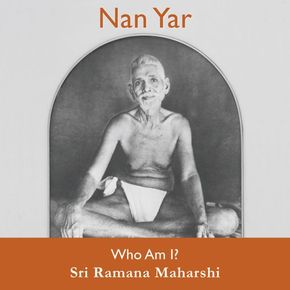| Verlag | Open Sky Press |
| Auflage | 2015 |
| Seiten | 112 |
| Format | 15,2 x 15,2 x 1 cm |
| Gewicht | 265 g |
| Artikeltyp | Englisches Buch |
| ISBN-10 | 0957462751 |
| EAN | 9780957462755 |
| Bestell-Nr | 95746275EA |
Nan Yar, meaning 'Who am I?', was originally spoken by Bhagavan Sri Ramana Maharshi in 1901, when he was twenty-one years old. Following his spontaneous moment of realisation as a sixteen- year-old school boy, Sri Ramana was drawn to Arunachala, a holy mountain in South India, which he never left. It was while he was living in a cave on the mountain's slopes that he was questioned
by a man called Sivaprakasam Pillai.'Sri Ramana wrote his answers with his finger in the sand
because this was the period in which he found it difficult to speak. Naturally this writing medium produced short, concise answers. 'Sivaprakasam Pillai didn't write down these answers.
After each new question was asked, Sri Ramana wiped out his previous reply and wrote a new one in the sand. When he went home, Sivaprakasam Pillai wrote down what he could remember of this silent conversation.'About twenty years later Sivaprakasam Pillai published these questions and answers as an appendix to a biography of Sri Ramana that he had written and published. There were thirteen questions and answers in this first published version.'Sri Ramana's devotees appreciated this particular presentation. Ramana Ashram published it as a separate booklet, and with each edition more and more questions and answers were added. The longest version has about thirty.'At some point in the 1920s Sri Ramana himself rewrote this series of questions and answers as a prose essay, elaborating on some answers and deleting others. This is now published under the title Who Am I? in Sri Ramana's Collected Works and separately as this small book. It is Sri Ramana's summary of answers written more than twenty years before.'
Nan Yar, or Who Am I? contains the core of Sri Ramana's teachings with a focus on Self-inquiry. Although Sri Ramana had not studied the scriptures when he first answered the questions, it is a spiritual classic that is in line with both the Vedanta [Indian philosophy] and Yoga traditions. He answered thequestions posed to him that day from the Self, reflecting the ancient wisdom of India and the contemporary wisdom of his time.
There is no doubt that the importance Sri Ramana gave to Self-inquiry as the most direct route to Self-realisation has attracted enormous attention from serious Western seekers of Truth in the last years. Not only his teachings have attracted attention but also his exemplary lifestyle and the sattvic [pure] nature of his mind - which are visibly reflected in the architecture of his ashram.
The paragraph that begins his essay was not given out in response to a question. It was composed by Sri Ramana when he was rewriting the work in the 1920s. Many philosophical works begin with a statement about the nature of happiness and the means by which it can be attained or discovered. Sri Ramana has followed this tradition.
It is with great pleasure that Open Sky Press has decided to make this classic text available in new translations in several European languages, ably supported by a host of recently digitally re-mastered photographs for which we thank Mr. Sundaram, President of Sri Ramana Ashram. A number of Sri Ramana's more important teaching quotations have been included.
John David (formarly Premananda) 2015 Open Sky Press

